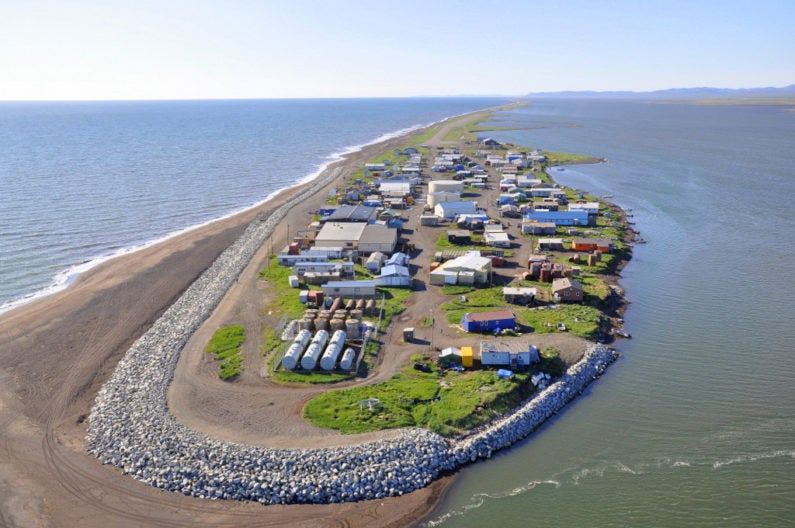March 27, 2017
Stanford researchers seek ways of keeping communities out of harm’s way in a changing climate
Based on examples from around the world, researchers chart the landscape for whether and how to implement the strategy of managed retreat – relocation or abandonment of development in the face of extreme weather risks.
By Rob Jordan
Predictions of more frequent extreme weather events put certain regions in the cross hairs of risks such as coastal flooding, heavy rain and erosion. To address an obvious but controversial solution – relocating from vulnerable areas – Stanford researchers analyzed cases of “managed retreat” around the world. Their findings provide a first-of-its-kind foundation for policymakers trying to decide whether and how to implement the strategy.

Kivalina, Alaska, is an example of a village threatened by climate change and extreme weather. (Image credit: ShoreZone / Flickr)
“Many people have an apocalyptic vision of what managed retreat means – ripping people out of their homes and letting buildings fall into the sea,” said lead author Miyuki Hino, a doctoral student in the Emmett Interdisciplinary Program in Environment and Resources. “In fact, there can be a huge potential benefit for the economy and for communities leaving the past behind and going to a better place. Still, it won’t be the right solution for everyone.”
Hard lessons can be found around the world: sea level rise could displace nearly 190 million people by the end of the century, according to a 2011 study. Last year, the United States alone suffered 15 natural disasters that each caused $1 billion or more in damage, according to the National Oceanic and Atmospheric Administration. Coastal communities threatened by sea level rise and heavy storms are particularly hard hit. In some areas, the cost to shore up eroding coastlines and rebuild storm-damaged homes is increasingly untenable.
“People will be on the move in a changing climate,” said co-author Katharine Mach, a senior research scientist in the School of Earth, Energy & Environmental Sciences. “We can respond in a managed, strategic way or in a way that is just fleeing disaster.”
Relocating communities and abandoning at-risk structures might make sense on paper, but the social, cultural and psychological obstacles can be insurmountable. The strategy is also less likely to find buy-in where structural protections such as sea walls and levees are in place. On the other hand, relocation can preserve community networks and culture. For some, resettlement can also open the door to new economic opportunities.
Hino and her co-authors analyzed 27 past and ongoing examples of attempts to implement managed retreat in 22 countries. From this, the researchers created a conceptual model based on who benefits from retreat and who initiates it. The model lays a foundation for understanding factors likely to impede or promote adoption of managed retreat in various circumstances.
The researchers categorized the examples they looked at with one of four labels based on whether residents initiated the retreat and how much support they got from the party that would be implementing the move through buy-outs, infrastructure changes or other financial support.
These labels group similar cases, such as when the residents initiate the retreat and receive government buyouts of high-risk properties. Other groupings include cases where residents don’t initiate the retreat, but, because of the greater good to the region, the government buys or elevates homes and creates a floodplain to protect downstream communities. In a third grouping, the residents did initiate retreat but failed to gain support of the government to implement the move.
The researchers found that relocation is most likely to occur when residents feel the environmental risks are intolerable, the retreat benefits broader society in some way, political will for retreat is high and a societal cost-benefit ratio justifies the move – a scenario the group labeled “mutual agreement.” By contrast, managed retreat rarely works when the benefits of retreat accrue to residents only or no one at all, or when political will is low and a societal cost-benefit ratio doesn’t justify relocation – a scenario they labelled “hunkered down.”
While rare, instances of communities voluntarily acting before disaster strikes – and other novel implementations of managed retreat – could shed light on how to get past various barriers to the approach, the researchers suggest. Among other avenues for exploration, the researchers suggest policymakers support community ownership of the relocation process, from selecting the resettlement location to designing its infrastructure. Before it comes to that, leaders would do well to create policies – such as permitting development until only the shoreline erodes to a certain point – that can support retreat if need be.
“We know change is coming, and there won’t be a one-size-fits-all solution for protecting and supporting communities at risk,” Hino said. “It makes sense to keep a range of options, including managed retreat, on the table.”
Mach is director of the Stanford Environment Assessment Facility at the Stanford Woods Institute for the Environment. Co-author Chris Field is the Melvin and Joan Lane Professor for Interdisciplinary Environmental Studies, the Perry L. McCarty Director of the Stanford Woods Institute, professor of biology and Earth system science and senior fellow at the Precourt Institute for Energy.
-30-
|